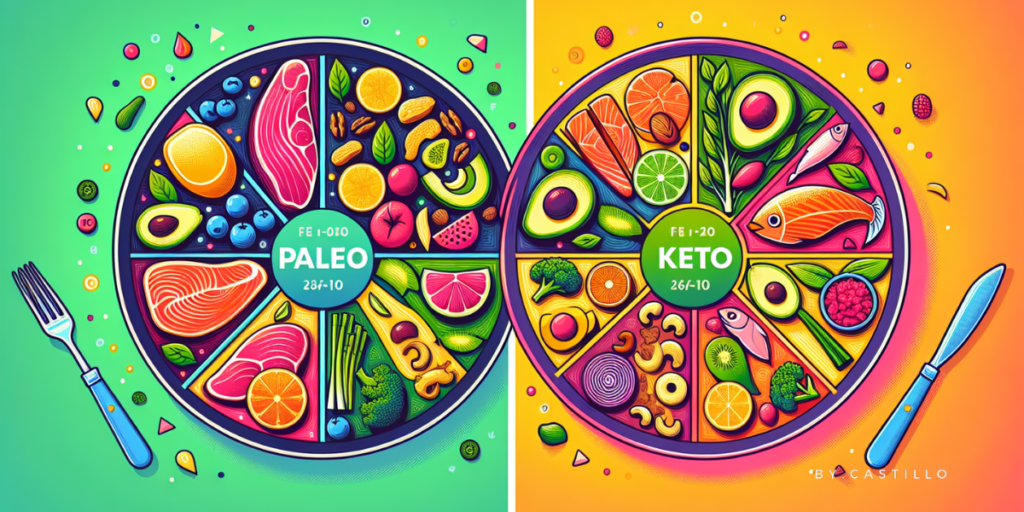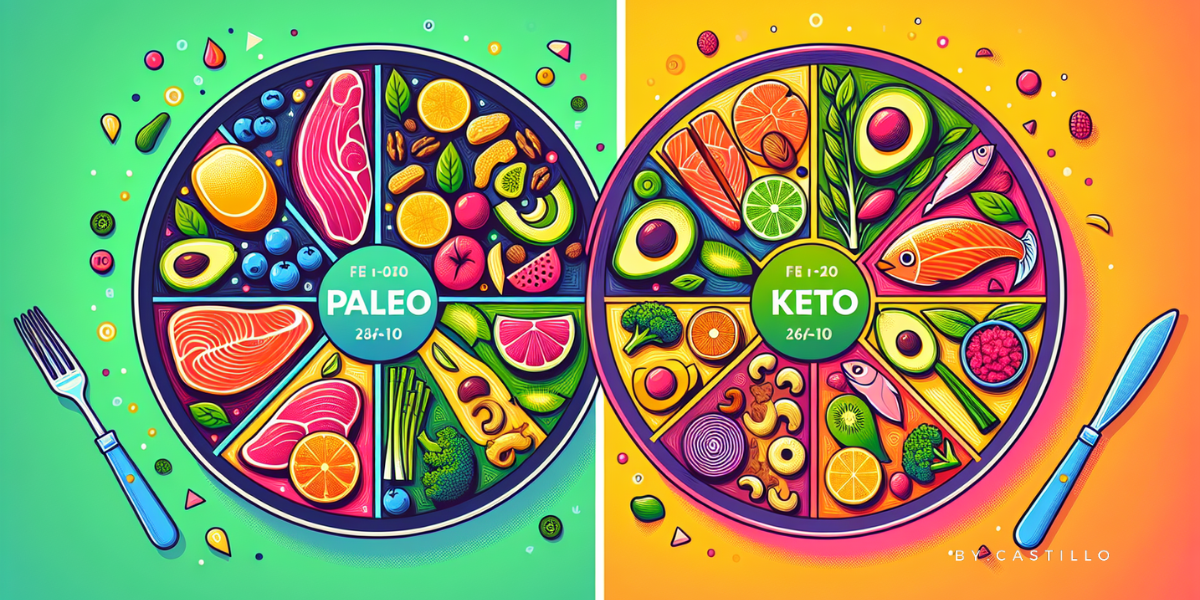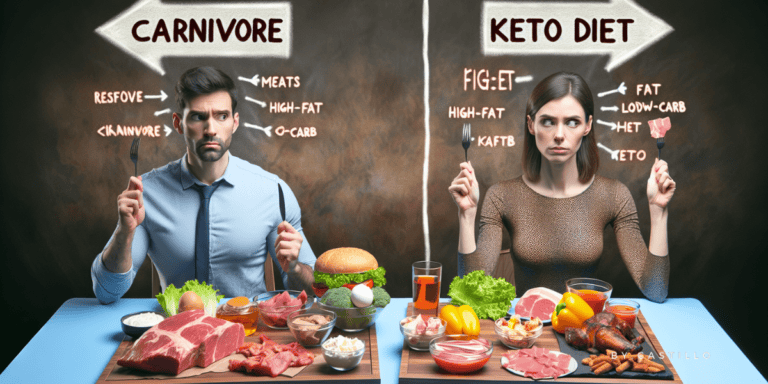Decoding Paleo vs Keto Diets: Choose Your Best Fit for Optimal Health
Comparing paleo vs keto?
Understandably, you want to choose a diet that best fits your health goals, whether it’s for weight loss, managing diabetes, or just feeling better. Paleo emphasizes natural, unprocessed foods while keto keys on high-fat, low-carb meals to thrust your body into ketosis. Both diets highlight nutrient-dense foods to support overall health.
We’ll dissect these diets, providing the clarity you need to decide which may cater to your health needs and lifestyle preferences.
Key Takeaways
The Paleo diet emphasizes a high intake of fruits, non-starchy vegetables, lean meats, healthy fats, and excludes grains, legumes, dairy, and processed foods.
The Keto diet, a low-carb diet, aims to induce ketosis by consuming high-fat, low-carb, moderate-protein foods, and restricts high-carb foods like grains, starchy vegetables, and fruits to maintain this metabolic state.
Both diets emphasize the consumption of nutrient-dense foods to support overall health.
Both Paleo and Keto diets offer health benefits like weight loss and improved insulin sensitivity, but have distinct macronutrient distributions, food restrictions, and potential long-term health risks that need to be considered.
Understanding Paleo: The Caveman Blueprint

The Paleo diet, also known as the caveman diet, is a diet plan that channels the dietary habits of our ancient ancestors from the Paleolithic era, a period when humans were hunter-gatherers.
Essentially, the Paleo diet focuses on consuming whole, unprocessed foods, nutrient-dense foods, similar to what our ancestors would have eaten during the Stone Age.
This diet promotes a high intake of fruits, lean meats, natural sweeteners, and non-starchy vegetables. As you can see, Paleo encourages individuals to eat foods rich in healthy fats and moderate protein.
On the other hand, it excludes foods that came into existence with modern farming practices such as grains, legumes, and dairy.
What You Can Eat on Paleo
When starting the Paleo diet, a variety of nutrient-dense foods and nutritious food choices are in store for you. The diet prioritizes non-starchy vegetables and lean meats, both of which are staples in the Paleo regimen.
Apart from these, healthy fats play a significant role in this diet.
Olive oil and walnut oil, for instance, are integral parts of the Paleo menu. Add to that an array of fruits such as berries, citrus fruits, and melons, and you have a flavorful, diverse range of foods to choose from.

High-quality animal proteins, nuts, seeds, and natural sweeteners like honey and maple syrup are also part of the Paleo list.
What to Sidestep on Paleo
While the Paleo diet offers a wide range of food choices, there are also certain foods that it strictly avoids.
A key principle of the Paleo diet is the elimination of highly processed foods. This means snacks like chips and cookies, as well as processed meats such as bacon, salami, and ham, are literally off the table.
The Paleo diet also excludes grains and legumes, which are staple components of many other diets. It also excludes dairy products, including cheese, milk, and cream, as these were not part of our Paleolithic ancestors’ diet.
Additionally, starchy vegetables such as corn, jicama, peas, and white potatoes are also not recommended for those following the Paleo diet or a low-carb diet.
Diving into Keto: The Low-Carb Fat-Burning Machine

The ketogenic diet, often referred to as the keto diet, is a low-carb diet that operates on a different set of principles.
The primary goal of the keto diet is to reach a state of ketosis, a metabolic condition where the body burns fat reserves instead of glucose for energy.
This state is achieved by a drastic reduction in carbohydrate intake and a significant increase in fat consumption.
Typical macronutrient ratios for a ketogenic diet:
70-80% fat
5-10% carbohydrate
10-20% protein
The body, when deprived of carbohydrates, enters a state of nutritional ketosis, leading to the utilization of fat stores for energy and an increase in ketone production.
What does this mean for you?
You turn your body into a natural fat-burning machine as long as you continue to eat healthy fats and stay in ketosis.
Keto-Friendly Foods
The keto diet, being a high-fat, low-carb regime, has a unique list of food choices.
Some examples of foods that are commonly consumed on the ketogenic diet include:
Avocados
Cheese
Fatty fish
Lard
Butter
Fatty cuts of meat
Nuts
Seeds
Plant oils
Oily fish

These foods are rich in both saturated fats and unsaturated fats, which are essential for the ketogenic diet.
Alongside these, a variety of protein sources such as:
meat
fish
eggs
nuts
seeds
are included in the diet. These healthy fats and protein sources are accompanied by non-starchy vegetables, providing a balanced meal structure with nutrient-dense foods.
Foods to Exclude on Keto
Just as there are key foods included in the Keto diet and low-carb diet, there are also foods that need to be avoided.
The ketogenic diet aims to keep total carbohydrate intake below 50 grams per day to maintain ketosis.
For this reason, starchy vegetables like potatoes, corn, and sweet potatoes are off-limits due to their high carbohydrate content. Grains, fruit, sugar, bread, pasta, and rice must also be avoided on the keto diet to keep carbs low.
While the Paleo diet allows a broader variety of fruits and some starchy vegetables, the Keto diet is much stricter in limiting carbohydrates.
Comparing Paleo vs Keto Diets: Key Differences That Matter

Now that we have individually explored the Paleo and Keto diets, let’s delve into their key differences.
While both diets promote the reduction of carbohydrate intake and the consumption of whole, unprocessed foods, they diverge significantly in terms of macronutrient balance and specific food group restrictions.
The Paleo diet focuses on whole, unprocessed foods, similar to what pre-agricultural humans consumed, and avoids processed foods, grains, and legumes. On the other hand, the Keto diet alters macronutrient composition by heavily limiting carbohydrates to induce a state of ketosis, which differs from the Paleo diet’s approach as a low-carb diet.
Macronutrients Breakdown
In terms of macronutrient breakdown, the Paleo and Keto diets have distinct approaches.
The ketogenic diet requires a low-carb diet:
a high fat intake, approximately 75% of dietary fat
around 15-20% of protein
a minimal amount of carbohydrates, up to 10%, usually not exceeding 25 net grams of carbs per day.
Conversely, the Paleo diet comprises:
roughly 40% protein
35% fat
25% carbohydrates
Emphasizing a balance between macronutrients which can be adjusted based on individual goals.
This balanced macronutrient distribution of the Paleo diet is significantly different from the Keto diet’s emphasis on fat consumption and very low carbohydrate intake to promote ketosis.
These different macronutrient ratios reflect the underlying principles of each diet.
Distinct Food Groups
When it comes to food groups, nutrient-dense foods are a focus in both the Paleo and Keto diets, which also have their unique approaches.
The Paleo diet allows the consumption of starchy vegetables such as sweet potatoes, beets, and carrots in moderation, while the Keto diet encourages the consumption of dairy foods like full-fat milk, butter, and natural yogurts.
Dairy, therefore, is excluded from the Paleo diet but is a key component of the Keto diet. Unique to the Keto diet, soy-based products such as tofu, tempeh, and soybeans are allowed, unlike in the Paleo diet.
Health Benefits Unveiled

Both the Paleo and Keto diets have been linked to a number of health benefits, particularly due to their emphasis on nutrient-dense foods.
These diets are associated with:
Weight loss
Improved cardiovascular health
Paleo is linked to a lower risk of cardiovascular diseases by avoiding processed foods
Keto demonstrates reductions in body weight, BMI, cholesterol, and blood glucose level in a 66-patient study.
Moreover, both diets have been recognized for improving insulin sensitivity and blood sugar control due to their rich protein and healthy fats.
They may even offer benefits to mood and mental health, with the Keto diet’s reduction in Parkinson’s disease symptoms suggesting potential neurological health benefits.
Weight Management
When it comes to weight management, both diets provide promising results.

The Paleo diet, by eliminating processed foods, may support weight loss and help maintain a healthy weight.
On the other hand, the ketogenic diet induces weight loss through a metabolic state called nutritional ketosis, where the body primarily burns fat for energy instead of carbohydrates.
This low-carb diet approach is central to the Keto diet’s effectiveness. Both diets, therefore, can support weight loss and weight management, although through different mechanisms.
Beyond Weight Loss
Beyond weight loss, the Paleo and Keto diets have been linked to other health benefits, including the consumption of nutrient-dense foods.

The Paleo diet, for instance, has been shown to positively impact cardiovascular markers such as blood pressure, cholesterol, and triglyceride levels in the short term.
The ketogenic diet, on the other hand, may lead to an increase in cholesterol and potential heart health issues due to its high saturated fat content from animal food sources.
Both the Paleo and Ketogenic diets have anti-inflammatory effects and may benefit individuals with autoimmune disorders.
The production of ketones in the Ketogenic diet has been associated with weight loss, improved blood sugar control, and reduced inflammation.
Lifestyle Considerations: Sustainability and Social Impacts

When considering a diet, it’s essential to evaluate not only the health benefits but also the sustainability and social impacts of the diet.
In this regard, the Paleo diet, with its greater food variety, tends to be easier to adhere to over the long term compared to the Keto diet. The ketogenic diet imposes strict adherence to macronutrient ratios, which can be challenging for long-term maintenance on a low-carb diet.
The Paleo diet accommodates a broader range of foods, making it more conducive to social dining and less restrictive in a variety of settings. These adherence and social factors contribute to the overall lifestyle sustainability of the Paleo diet compared to the ketogenic diet.
Ease of Adherence
Commitment to a diet is crucial for its effectiveness.
The Paleo diet, with its broad selection of allowed foods like fruits and tubers, offers flexibility and tends to be easier to stick to compared with the Keto diet’s carbohydrate restrictions.
On the other hand, Keto diet adherence can be challenging due to the need for rigorous counting of net carbs and strict macronutrient ratios which restrict almost all sources of carbohydrates in a low-carb diet. This is why some people may start with a lazy keto approach before starting a strict keto diet.
Therefore, a sustainable diet that promotes long-term commitment should not only align with personal food preferences but also integrate well with an individual’s lifestyle.
Social Dining
Social dining is a significant aspect of our lives, and dietary restrictions can sometimes pose challenges in these contexts.
Both Paleo and Keto diets require planning and preparation for social dining situations, especially when traveling or dining out.
Dining out and social eating can be more difficult on a ketogenic diet due to its strict low-carb requirements, which can limit food options and make it harder to partake in common social meals.
Selecting between Paleo and Keto diets involves considering flexibility in food choices and the ability to maintain the diet in various social situations.

Potential Risks and Precautions
While both diets offer a number of health benefits, it’s essential to be aware of the potential risks and precautions associated with each diet.
The long-term health benefits and potential risks of the Paleo diet are not well-researched, and the consumption of processed meats, a concern in any diet, may increase the risk of cancer and other health issues.
Individuals with organ conditions involving the pancreas, liver, thyroid, or gallbladder are advised not to follow the ketogenic diet or any low-carb diet.
It is advised to monitor LDL-C and other markers of heart health before and after starting a ketogenic diet due to potential cardiovascular health risks.
Keto Cautions

The long-term effects of the Keto diet are not fully understood, and as a low-carb diet, it casts doubt on its sustainability for health and weight maintenance over time.
High levels of protein and saturated fat intake, common in the Keto diet, have been associated with increased risks of kidney and heart disease, and certain cancers.
Diabetics may require adjustments to their medications after beginning a ketogenic diet due to significant effects on blood sugar levels.
Excluding whole food groups as seen in Keto and Paleo diets may lead to nutrient deficiencies and possibly alter the gut microbiome.
Paleo Pitfalls

Despite its benefits, the Paleo diet has some potential pitfalls, even when focusing on nutrient-dense foods. The diet’s exclusion of foods like whole grains, legumes, and dairy can lead to potential deficiencies in nutrients these foods provide.
A frequent caution for individuals on the Paleo diet is to ensure adequate calcium intake, which is commonly sourced from dairy products not consumed on this diet.
There is a potential risk for micronutrient deficiencies in the Paleo diet, particularly for calcium and vitamin D, both of which are critical for maintaining bone health.
How to Choose Between Paleo and Keto
Choosing between the Paleo and Keto diets should involve careful consideration of your personal health objectives and lifestyle, particularly if you are looking for a low-carb diet.
Speaking with a healthcare provider is crucial before starting either diet, particularly for individuals with pre-existing health issues.
Selecting the appropriate diet for your health involves collaboration with a healthcare provider to navigate personal health objectives. Existing health conditions such as diabetes or heart disease may require adapted dietary choices between Paleo and Keto to safely manage these conditions.
Summary
We’ve navigated the realm of Paleo, Keto, and low-carb diets, decoded their principles, and compared them in terms of their macronutrient breakdown, food choices, health benefits, lifestyle considerations, and potential risks. Both diets, despite their differences, offer a range of health benefits including weight loss, improved cardiovascular health, and potential neurological benefits.
However, it’s important to remember that choosing a diet is a personal decision that should be made in consultation with a healthcare provider, taking into account personal preferences, health objectives, and lifestyle. Here’s to making informed choices for optimal health!
FAQs
What are the key differences between the Paleo and Keto diets?
The key difference between the Paleo and Keto diets is that the Paleo diet emphasizes whole, unprocessed foods, while the Keto diet focuses on heavily limiting carbohydrates to induce ketosis. Both diets aim to improve health and well-being by regulating food intake.
What are the health benefits of the Paleo and Keto diets?
Both the Paleo and Keto diets have health benefits such as weight loss and improved cardiovascular health. The Paleo diet is linked to a lower risk of cardiovascular diseases, while the Keto diet has shown reductions in body weight, BMI, cholesterol, and blood glucose levels.
Are there any potential risks associated with the Paleo and Keto diets?
There is limited research on the long-term health benefits and potential risks of the Paleo diet, while the Keto diet may carry an increased risk of heart disease. It’s important to consider these factors before starting these diets.
Which diet is easier to adhere to?
The Paleo diet is generally easier to adhere to compared to the Keto diet due to its greater food variety, making it more sustainable for the long term.
How should I choose between the Paleo and Keto diets?
Consider your personal health objectives and lifestyle when choosing between the Paleo and Keto diets. It’s essential to consult with a healthcare provider, especially if you have pre-existing health issues.







